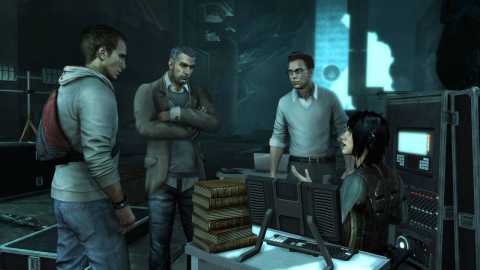
Assassin’s Creed has always been a pretty complex machine. Right from the start, Ubisoft has played up the deliberately impenetrable premise of modern-day assassins and Templars fighting an ancient secret war, training their agents with technology that allows them to relive their assassinatin’ or Templarin’ ancestors’ experiences by tapping into their genetic memory. Turns out they didn’t need to try and obfuscate; as you head into Assassin’s Creed III--actually the fifth in the “main” Assassin’s Creed story, not even taking into consideration the handful of handheld digressions--the threat of a prophesized global apocalypse, cryptic messages from a highly advanced, long-dead civilization, and the emergence of the protagonist as a Christ figure make the game’s stratospherically high concept seem tame by comparison.
Wrapping up five games worth of dense mystery and complex, wide-reaching gameplay systems while simultaneously establishing an as-yet-unseen historical era and accompanying meta-protagonist, as Assassin’s Creed III attempts, is a staggeringly ambitious undertaking. It’s impressive that the game succeeds as often as it does, particularly with regards to the game’s vision of the American Revolutionary War as seen through the conspiratorial cloak-and-dagger lens of the Assassin’s Creed universe, and the new gameplay systems that are tailored to address both the era and its scattered geography. The game stumbles a bit, though, when it comes to linking all of these systems together in a meaningful way, leaving you with an overabundance of side activities that, while often interesting on their own, feel inessential to the narrative progression. Assassin’s Creed III has pacing issues, too, spending hours upon hours up front before you even meet the game’s main protagonist, then rushing at a dead sprint towards the end, hastily and underwhelmingly wrapping up story threads that the series has spent years laying out.
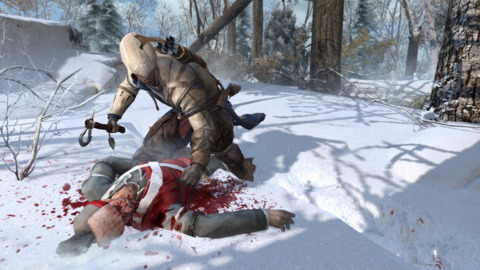
Assassin’s Creed III would’ve had plenty of heavy lifting to do had it chosen to focus purely on the conclusion of Desmond Miles’ story, the reluctant assassin whose brainpan has served as center stage for the series so far. Having already experienced the highlight reels of ancestors Altaïr Ibn-La'Ahad and Ezio Auditore on his quest to at first save the assassins, then eventually the world, the questions about Desmond and the increasingly fantastical world around him have been piling up, and it’s time to make good on those promises. Much of that mythology gets addressed in Assassin’s Creed III, but as is often the case, the mystery is more interesting than the answers. Make no mistake, the fate of Desmond Miles and the immediate cosmic fate of the world at large are answered, though without the sort of finality that would prevent Ubisoft from continuing to move forward with the Assassin’s Creed story.
The sequences where you play as Desmond have been expanded a bit over past games, but his story, which concerns itself with Desmond’s strained relationship with his father as much as it does decrypting the final pieces of the First Civilization puzzle, is still largely told in the margins. While there has always been a disconnect between Desmond and his ancestor, Assassin’s Creed III does a better job of establishing direct thematic connections between Desmond and the real star of the show, Connor Kenway, the son of an English nobleman and a Native American woman living in the American Northeast during the time of the American Revolutionary War. Whereas Altaïr was a bit of a cipher, his character largely defined by his stubborn adherence to the dogma of the assassin’s code, and Ezio was all swagger and swashbuckle, Connor is a naive idealist filled with righteous fury, having been caught in the conflict between both the assassins and the Templars, as well as between the European colonists and his own people, since before he was even born. Connor’s uncompromising sense of honor and justice serve Assassin’s Creed III well as it plunges him right in the middle of the American Revolutionary War. While American history has always lionized the founding fathers, any war is mostly a series of bad compromises, and the game gets some mileage out of good men making bad choices.
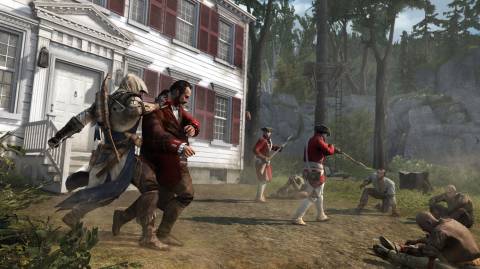
Historical settings are a fundamental part of the Assassin’s Creed experience, but Connor’s story is inextricably interwoven with the course of the war itself in a way that the series has rarely approached. You won’t just bear witness to famous historical events like the Boston Tea Party, The Battle at Lexington and Concord, or Paul Revere’s Ride, you’ll actually take part in them, oftentimes setting them in motion in the first place. It can feel a little silly at times, bordering on Forrest Gump/National Treasure territory, but it’s no small part of Assassin’s Creed III’s effort to give the game a distinct sense of place.
Geography is important to the politics of Assassin’s Creed III, and the ways in which it sets the gameplay here apart from previous games cannot be overstated. Assassin’s Creed has primarily dwelled in dense, ancient cities that have spent thousands of years building upwards towards a dizzying sense of verticality. Such infrastructure doesn’t exist, at least not with the same density, in Boston, New York, and the wilderness in-between during the mid-to-late 1700s, which is when and where Assassin’s Creed III primarily takes place. Other than streamlining the free-running system to make it much harder to accidentally leap to your death--which is a convenience when you’re in-town and an absolute necessity when you’re scampering along tree branches in the new wilderness area--the basic traversal mechanics of Assassin’s Creed remain largely unchanged. Because of the more wide-open geography, as well as a more generous, if somewhat-inconsistent fast-travel system, though, I found myself inherently taking to the rooftops less often to avoid trouble.
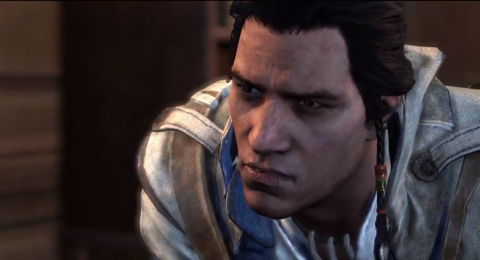
The fast-travel system also plays into the issues with side missions in Assassin’s Creed III. After learning its lesson with the mission monotony of the original Assassin’s Creed, the series has been jam-packed with a variety of distractions, from real estate and empire-building to item-collection and crafting, sometimes to the point of being overstuffed. Assassin’s Creed III rolls back some of the clumsier activities introduced in Revelations, and simplifies others, but it introduces a number of new ones, and there’s still plenty of trouble to get into before taking on the next story mission. You can help frontiersmen in need to build up your homestead, Connor’s base of operations; hunt and collect skins from a variety of skittish animals in the wilderness; take to the open seas as a privateer and battle others in the thrilling and visually stunning naval battles; and intervene in random encounters between villainous Redcoats and innocent civilians, just to name a few.
They’re not all winners, but the real problem is how inessential all of the side activities feel. Being able to more easily fast travel across large swaths of land means it’s easier to simply miss a lot of these activities. In the past, the simple act of getting from Point A to Point B--beyond being one of the simple, fundamental pleasures of playing Assassin’s Creed--would expose you to a lot of this stuff, and it was easy to take a quick detour and buy a building, stab a guy, collect a feather, or whatever. The bigger problem is that, beyond the early missions that initially introduce the different types of side activities, the main story progression gives you little reason to ever engage in any of this stuff. Some of it, like the naval missions, are fun enough on their own, but more often than not, I found my compulsion to see the next story beat unfold far outweighed any of the other distractions presented.
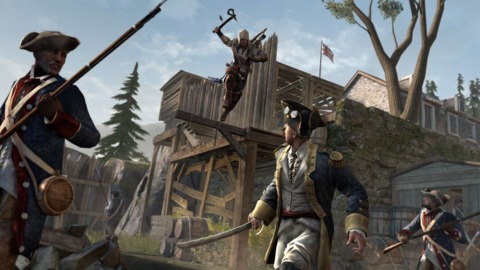
Issues of cohesion aside, I still found Assassin’s Creed III fundamentally enjoyable to play. Story missions that focus on eavesdropping on enemy conversations or chasing enemies through the streets can be unforgiving and frustrating, but there’s generally a good variety to them, and the free-flowing, kinetic combat system, while mostly familiar, is still as brutal and satisfying as ever. As you might expect from the radical change in location, Assassin’s Creed III is a much different-looking game than its predecessors, and while there are frame-rate and pop-in issues, it can be an intermittently gorgeous game, with its heavy weather effects and the open wilderness standing out as particular highlights.
The unique Assassin’s Creed multiplayer first introduced in Brotherhood continues to get refined in Assassin’s Creed III. Previously contextualized as a training simulation to help Templar soldiers fight the assassins on their own terms, Abstergo has brazenly taken its Animus project mainstream, selling it to the public as the next big gaming system through a series of convincingly phony live-action advertisements that you unlock as you level up. Some minor gameplay tweaks have been made, such as adding audio cues to let you know when you’ve got line-of-sight on your target or when your hunter has line-of-sight on you. In addition to the returning suite of high-tension player-versus-player modes, there’s a new co-op mode called Wolf Pack, where four players team up against a series of increasingly wily AI targets while a countdown clock limits your progression to the next target. It’s the Assassin’s Creed version of wave-based survival, and it can be fun, and less stressful than the PvP, though like most Horde modes, you’ll want to assemble a familiar group if you really want to succeed.
Assassin’s Creed III is a step up from last year’s Assassin’s Creed: Revelations, which saw Ezio’s story overstay its welcome and made some major miscalculations with its new mechanics, but it’s still not Assassin’s Creed at its finest. It's successful at establishing a whole new world and cast of characters, and tailoring the gameplay to match that setting, which is no small feat, even if the puzzle pieces don’t fit together as well as they could.